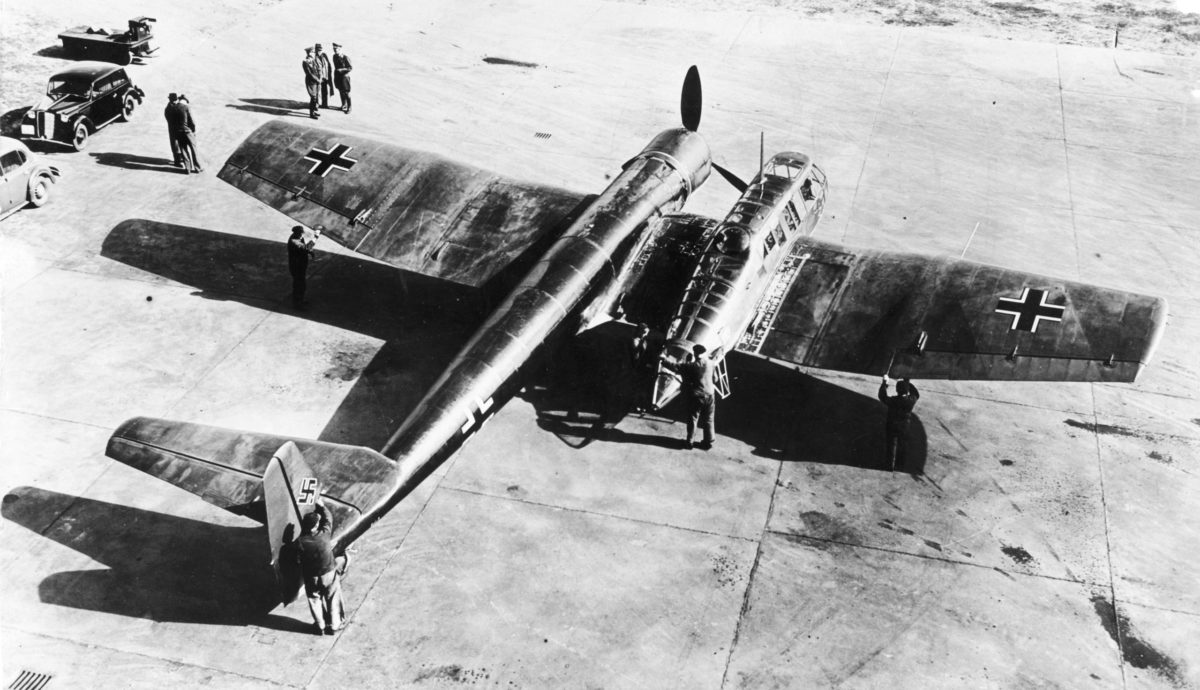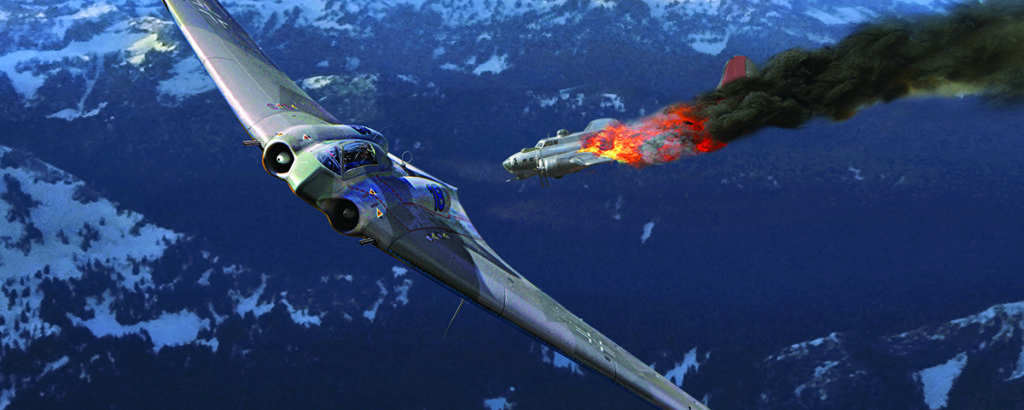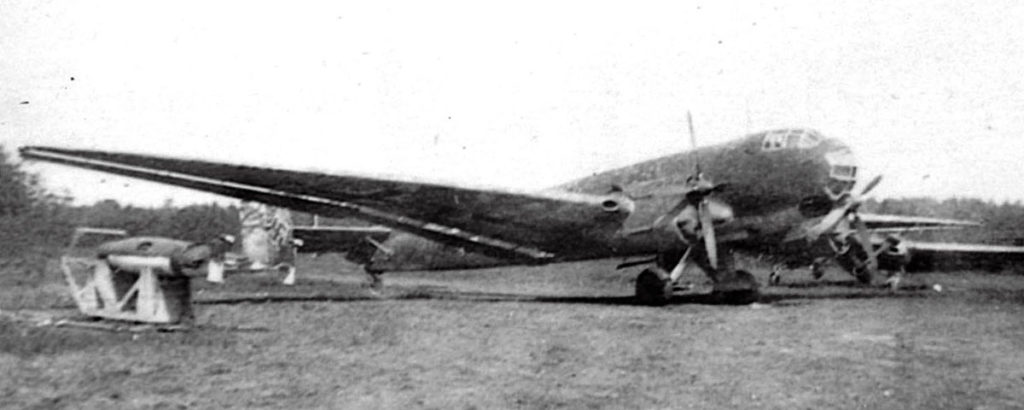In 1937, the German Air Ministry issued a specification for a single-engine three-seat short-range reconnaissance and observation aircraft, with the emphasis on good all-round visibility. The requirement drew responses from Arado and Focke Wulf, in addition to the novel approach of Blohm und Voss’ Richard Vogt, then head of Hamburger Flugzeugbau, which Blohm und Voss had recently purchased.
Blohm und Voss was primarily known at the time for building flying boats. The unorthodox design of the Bv-141, however, featured an asymmetric layout — a single radial engine was installed at the forward end of a port-side tail boom, with the extensively windowed crew nacelle mounted to starboard. The Air Ministry was predictably appalled by this strange configuration and refused to approve a single example for production. When the design was submitted, there were scowls and snickers and suggestions that Blohm und Voss should stick to flying boats.
GET HISTORY’S GREATEST TALES—RIGHT IN YOUR INBOX
Subscribe to our HistoryNet Now! newsletter for the best of the past, delivered every Monday and Thursday.
Was the bv-141 the First asymmetrical plane?
The concept of an asymmetric aircraft actually dates back to World War I. Designs such as the Gotha G.VI, built in 1918, were intended to provide their crews with a better view and a heavier concentration of firepower. But the Gotha design saw little development and never went into production.
The plane that emerged from Vogt’s concept, the Bv-141 was remarkably aerodynamic even though it was undoubtedly the most unorthodox-looking aircraft constructed during World War II. It was 39 feet, 10 inches long, with a wingspan of 50 feet, 8 inches and weight of 8,600 pounds, putting it in almost the same size and weight class as the Messerschmitt Bf-110.
Powered by a 865-hp BMW 132 radial engine, the Bv-141 had a respectable (for 1938) top speed of 248 mph and a ceiling of 29,530 feet, while its 700-mile range was almost twice that of its closest competitor, the Focke Wulf Fw-189. The Fw-189 was a light twin-engine aircraft intended to give maximum possible visibility to the observer. The cockpit was completely windowed and formed a single transparent shell; the tail section was a twin-boom configuration like the Lockheed P-38’s, which made for a wide field of visibility toward the rear. Flight stability, especially at lower speeds, was almost ideal for observation purposes. Most Air Ministry officials preferred the Fw-189.
But while traditionalists disdained the Bv-141’s lopsided design, Ernst Udet, head of the Luftwaffe’s technical development department, encouraged Vogt. Udet’s comments sufficiently impressed Blohm und Voss’ board of directors that it decided to develop the aircraft as a private venture at company expense. When Udet flew the prototype on Feb. 25, 1938, he found it had docile characteristics and met the requirements of the specification.
Recommended for you
BV-141’s Variants
The Bv-141 was followed by the Bv-141A, equipped with a symmetrical horizontal stabilizer and elevator; it proved to be an excellent aircraft, but the air ministry rejected it as underpowered. The more powerful Bv-141B, which had an asymmetrical horizontal stabilizer and elevator to allow the rear gunner a clear field of fire, proved to have handling problems.
The third aircraft, equipped with wider track landing gear because of some gear collapses on landing, was armed with two fixed forward-firing 7.92 mm MG 17 machine guns, plus two MG 15 guns of similar caliber firing to the rear. Able to carry a camera and racks for four 110-pound bombs, that plane proved sufficiently successful during initial trials for the factory to receive an order from the Air Ministry for five examples of the preproduction Bv-141A. Each prototype featured different measurements and placements of the cockpit. The cockpit layout itself was also changed, with both stepped and streamlined forms tested. When the Air Ministry heard about the successes gained by the designers, it ordered five evaluation planes. These became the Bv-141A series, easily recognized by its symmetrical horizontal stabilizer and elevator.
Both A and B types had hydraulic problems. Extended flight testing did not succeed in freeing members of the Air Ministry’s technical staff from their concerns about the plane’s unusual configuration. In the end, although the aircraft showed that it had good general qualities, only 13 Bv-141s were built before the Air Ministry shut down production in favor of the Fw-189.
Was the BV-141 flyable?
Trials had shown that the Bv-141 was in fact quite stable in the air. A conventional single-engine aircraft, with its center of gravity on the aircraft centerline, experiences a left turning tendency known as the slipstream effect — the clockwise (as seen from the cockpit) corkscrewing airflow down the length of the fuselage because of the spinning propeller. This airflow strikes the vertical tail’s left side; that causes the tail to swing to the right, and thus the nose of the aircraft to the left. Since the Bv-141 was asymmetrical, with its center of gravity between the engine and the cockpit, the left- turning tendency from the slipstream effect was canceled out by the drag of the cockpit nacelle, which tended to move the nose of the aircraft to the right.
Luftwaffe commander Hermann Göring showed absolutely no interest in Blohm und Voss’ unorthodox design. The A series was denounced, dismissed as underpowered, and plans for production were terminated. When engineers built the B series, they used the same 1,560-hp BMW 801A engine that was installed in the Fw-190. Since that power plant was bigger than the Bramo Fafnir engine used in the A series, the entire plane had to be enlarged and strengthened. The horizontal stabilizer and elevator also became asymmetrical.
Production history of the Bv-141B
Five prototypes of the B series were built. The second prototype was flown to a testing facility in the spring of 1941, and the plane continued to make a good overall impression. As a result, the design team proposed developing a couple more aircraft for use on the Eastern Front.
Those plans never came to fruition. The Fw-189 was by that time strongly entrenched in the production cycle, and Blohm und Voss assembly lines were being used to produce the Fw-200 Condor, as the original Focke Wulf factory had been bombed to oblivion.
Tests with the second prototype in autumn 1941 proved less successful than with the original design. The airframe had become too heavy. It might have been better to use the 1,200-hp Bramo Fafnir 323R2 engine, but the designers wanted to make sure that Göring wouldn’t be able to complain about inadequate power. The new design had given up speed and maneuverability, and it was now difficult to perform rolls. In the end, Göring himself ordered Blohm und Voss to cease work on the project. The Luftwaffe opted to mass-produce the Fw-189 instead.
Was the Bv-141 a Failure?
Many analysts look back on the Bv-141 as the most remarkable aircraft of WWII, but they generally regard it as a failure. It was indeed remarkable, but it wasn’t a failure. The plane initially was good — better than the Fw-189. But the design team simply ran into too much opposition from the Air Ministry in the course of development. More asymmetric designs were subsequently proposed, but they never came into being before the war ended and the design team was dispersed.
In 1943 Vogt was permitted to develop a dive-bomber and attack aircraft, the Bv-237, around the same concept. That aircraft featured an armored fuselage nacelle and would have carried only a pilot in the dive-bomber configuration, but a pilot and a tail gunner in the attack configuration. In the latter version, the armament included three 30 mm MK 103 cannons, along with two fixed 13mm MG 131 machine guns and a pair of similar weapons for the tail gunner. The B-1 series was anticipated to have an auxiliary turbojet engine under the fuselage. Although design work reached an advanced stage, the Air Ministry decided against constructing a prototype. Production efforts were subsequently concentrated on a smaller number of less specialized aircraft.
Despite its eventual failure to achieve full-scale production, the Bv-141 can be looked upon as a good representation of what the Allies came to fear about the Nazis: combining ingenuity, unorthodoxy and advanced engineering to achieve their goals. As the war continued to turn against it, the Third Reich would produce more advanced unique aircraft such as the Messerschmitt Me-262 jet fighter and the Me-163 rocket fighter, where desperation was as much a mother of invention as necessity.
Originally published in the November 2006 issue of Aviation History.
historynet magazines
Our 9 best-selling history titles feature in-depth storytelling and iconic imagery to engage and inform on the people, the wars, and the events that shaped America and the world.








